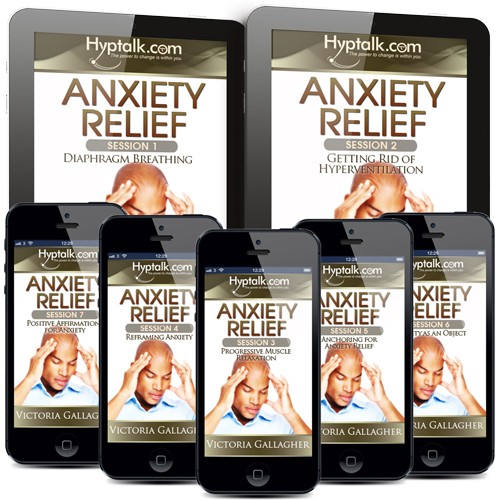Anxiety Vs. Anxiety Disorders
Anxiety is an inevitable part of life in contemporary society. It's important to realize that there are many situations that come up in everyday life in which it is appropriate to react with some anxiety. If you didn't feel any anxiety in response to everyday challenges involving potential loss or failure, something would be wrong.
Anxiety Disorders are distinguished from everyday, normal anxiety in that they involve anxiety that 1) is more intense (for example, panic attacks), 2) lasts longer (anxiety that may persist for months instead of going away after a stressful situation has passed), or 3) leads to phobias that interfere with your life.
Here are the most common anxiety disorders:
Panic Disorder | Agoraphobia | Social Phobia | Generalized Anxiety Disorder | Obsessive-Compulsive Disorder | Post-Traumatic Stress Disorder
Panic Disorder
Characterized by sudden episodes of acute apprehension or intense fear that occur "out of the blue" without any apparent cause. Intense panic usually lasts no more than a few minutes, but, in rare instances, can return in "waves' for a period of up to two hours. During the panic itself, any of the following symptoms can occur:
* Shortness of breath or a feeling of being smothered.
* Heart palpitations--pounding heart or accelerated heart rate.
* Dizziness, unsteadiness, or faintness.
* Trembling or shaking
* Feeling of choking
* Sweating
* Nausea or abdominal distress
* Feeling of unreality--as if you're "not all there"
* Numbness, pain, or tingling in hands, feet, arms, legs, fingers, toes, lips, face.
* Hot and cold flashes
* Pain or discomfort in chest, upper back, shoulder blades.
* Fears of going crazy or losing control
* Fears of dying
This type of attack is NOT brought on by phobias or anything you are thinking about. It is spontaneous, unexpected, and occurs for no apparent reason.
Panic Attacks can be reduced by adopting a personal wellness program including regular exercise, daily practice of deep relaxation, good nutrition, and a shift in attitude to a calmer, more easygoing approach to life.
Agoraphobia
The word agoraphobia means fear of open spaces; however, the essence of agoraphobia is a fear of panic attacks. If you suffer from agoraphobia, you are afraid of being in situations form which escape might be difficult--or in which help might be unavailable--if you suddenly had a panic attack. You may avoid grocery stores or freeways, for example, not so much because of their inherent characteristics, but because these are situations form which escape might be difficult or embarrassing in the event of panic. Fear of embarrassment plays a key role. Most agoraphobics fear not only having panic attacks but what other people will think should they be seen having a panic attack.
It is common for the agoraphobic to avoid a variety of situations. Some of the more common ones include:
* Crowded public places such as grocery stores, department stores, restaurants
* Enclosed or confined places such as tunnels, bridges, or the hairdresser's chair
* Public transportation such as trains, buses, subways, planes
* Being at home alone
Perhaps the most common feature of agoraphobia is anxiety about being far away from home or far from a "safe person" You may be afraid of driving alone beyond a certain short distance from home. In more sever cases, you might be able to walk alone only a few yards from home or you might be housebound altogether.
Agoraphobia is usually brought on by having panic disorders in the first place. At first you simply have panic attacks that occur for no apparent reason. After awhile, you may find that your attack become more frequent in confined situations. You begin to fear those situations. After awhile, you simply avoid those situations altogether, which will take you from a mild case to a more moderate problem. Severe agoraphobia is restriction of all outdoor activities without being accompanied.
Agoraphobia is very treatable. The first step is learning to relax and to cope with panic attacks. The next step is gradual exposure, beginning first with imagining and then graduating to real life. Three, learning constructive ways of thinking rather than worrying all the time. All of these techniques and more are available in the "Anxiety Relief" CD.
Social Phobia
Social Phobia is one of the more common anxiety disorders. It involves fear of embarrassment or humiliation in situations where you are exposed to the scrutiny of others or must perform. This fear is much stronger than the normal anxiety most non-phobic people experience in social or performance situations. Usually it's so strong that it causes you to avoid the situation altogether, although some people with social phobia endure social situations, with considerable anxiety. Typically the concern is being viewed or judges as being anxious, weak, "crazy," or stupid. The concern is generally out of proportion to the situation, and you recognize that it's excessive. The most common social phobia is fear of public speaking. In fact, this is the most common of all phobias and affects performers, speakers, people whose jobs require them to make presentations, and students who have to speak before their class. Public speaking phobia affects a large percentage of the population.
Other common social phobias include
* Fear of blushing in public
* Fear of choking on or spilling food while eating in public
* Fear of being watched at work
* Fear of using public toilets
* Fear of writing or signing documents in the presence of others
* Fear of crowds
* Fear of taking examinations
Treatment for social phobia is often best carried out in a group setting. The best treatment combines exposure to social settings along with restructuring of mistaken beliefs associated with embarrassment and fear of rejection.
Generalized Anxiety Disorder
Generalized anxiety disorder is characterized by chronic anxiety that persists for at least six months but is unaccompanied by panic attacks, phobias, or obsessions. You simply experience persistent anxiety and worry without the complicating features of other anxiety disorders. It's common that you would have a large number of worries, and to spend a lot of your time worrying.
Other symptoms would include:
* Restlessness--feeling keyed up
* Being easily fatigued
* Difficulty concentrating
* Irritability
* Muscle tension
* Difficulties with sleep
Some basic fears associated with generalized anxiety disorder are:
* Fear of losing control
* Fear of not being able to cope
* Fear of failure
* Fear of rejection or abandonment
* Fear of death and disease
Generalized anxiety disorder can be aggravated by any stressful situation that elicits these fears, such as increased demands for performance, intensified marital conflict, physical illness, or any situation that heightens your perception of danger or threat.
You can alleviate generalized anxiety disorder by using imagery and real life desensitization, reducing muscle tension through regular exercise, relaxation, and good nutrition. Positive self-talk, expressing your feelings, and modifying basic beliefs that perpetuate the anxiety are crucial. Additionally, working on your self-esteem will help you with feelings of insecurity or inadequacy, which may underlie the anxiety. Again, many of these issues are tackled in the "Anxiety Relief" CD.
Obsessive-Compulsive Disorder
Some people naturally tend to be more neat, tidy, and orderly than others. These traits can in fact be useful in many situations, both at work and at home. In obsessive-compulsive disorder, however, they are carried to an extreme and disruptive degree. Obsessive-compulsive people can spend many hours cleaning, tidying, checking, or ordering, to the point where these activities interfere with the rest of the business of their lives.
Obsessions are recurring ideas, thoughts, images, or impulses that seem senseless but nonetheless continue to intrude into your mind. Examples include images of violence, thoughts of doing violence to someone else, or fears of leaving on lights or the stove or leaving your door unlocked. You recognize that these thoughts or fears are irrational and try to suppress them, but they continue to intrude into your mind for hours, days, weeks, or longer. These thoughts or images are not merely excessive worries about real-life problems and are usually unrelated to a real-life problem.
Compulsions are behaviors or rituals that you perform to dispel the anxiety brought up by obsessions. For example, you may wash your hands numerous times to dispel a fear of being contaminated, check the stove again and again to see if it is turned off, or look continually in your rearview mirror while driving to assuage anxiety about having hit somebody. You realize that these rituals are unreasonable. Yet you feel compelled to perform them to ward off the anxiety associated with your particular obsession. The conflict between your wish to be free of the compulsive ritual and the irresistible desire to perform it is a source of anxiety, shame, and even despair.
One treatment is called exposure and response prevention. This involves systematically being exposed to situations that arouse obsessive thoughts and then being prevented from engaging in any compulsive behaviors. For example,you would be required to expose yourself to something you considered dirty, such as a doorknob, and then to reduce the number of times you wash your hands or refrain from washing at all. It is best to work with someone in these situations to help you enforce the new response pattern.
Post-Traumatic Stress Disorder
The essential feature of post-traumatic stress disorder is the development of disabling psychological symptoms following a traumatic event.
Post-traumatic stress disorder can occur in anyone in the wake of a severe trauma outside the normal range of human experience. These traumas that would produce intense fear, terror, and feelings of helplessness in anyone and include natural disasters such as earthquakes or tornadoes, car or plane crashes, rape, assault, or other violent crimes against yourself or your immediate family. It appears that the symptoms are more intense and longer lasting when the trauma is personal, as in rape or other violent cremes.
Symptoms of PTSD:
* Repetitive, distressing thoughts about the event
* Nightmares related to the event
* Flashbacks so intense that you feel or act as though the trauma were occurring all over again
* An attempt to avoid thoughts or feelings associated with the trauma
* An attempt to avoid activities associated with the trauma; such as a phobia about driving after an auto accident
* Emotional numbness--being out of touch with your feelings
* Feelings of detachment or estrangement form others
* Losing interest in activities that used to give you pleasure
* Persistent symptoms of increased anxiety, such as difficulty falling or staying asleep, difficulty concentrating, startling easily, or irritability and outbursts of anger.
In addition to the other ways of dealing with the other types of anxieties, the primary way of dealing with Post Traumatic Stress Disorder is to work through and deal with the intense feelings of fear, loss, and/or guilt surrounding the traumatic event. Hypnosis will help you by going back and walking through the original trauma.
Related Products:







